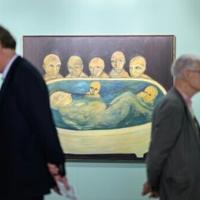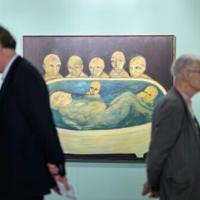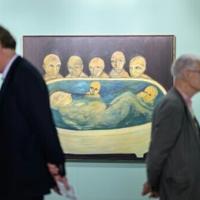Art Market
Shreya Ajmani
Feb 4, 2025 10:31AM
In a nation as abundant as India, the art that emerges is inevitably just as diverse. With the Indian art market continuing to gather momentum, collectors are increasingly drawn to artworks and artists that reveal untold stories and explore the country’s more obscure corners, often guided by intuition rather than convention.
Bolstered by a burgeoning pool of galleries across India and the subcontinent, a new generation of collectors is eager to engage with the region’s rich history and support a growing crop of artistic talent.
Artsy spoke to 10 collectors aged 35 or younger about their involvement in the burgeoning Indian art scene, where collecting is just one facet of their broader commitment to art—a promising development in a country brimming with untapped potential.
Rhea Kuruvilla
Art advisor and Frieze VIP consultant, Mumbai
Portrait of Rhea Kuruvilla. Courtesy of Rhea Kuruvilla.
Ramesh Mario Nithiyendran, Terracotta Figures 13, 2023. Courtesy of Jhaveri Contemporary and Rhea Kuruvilla.
At six years old, Rhea Kuruvilla took notice of a work by the Indian modernist Francis Newton Souza from her family’s collection. The experience left an immediate impression: “The distorted form and feverish scribbles appealed to my childlike sensibility,” Kuruvilla told Artsy. “It wasn’t until I grew older that I began to understand the way the work explores our inner chaos and the darker side of the human condition.”
Despite being exposed to Indian modernist masters and contemporary art at a young age, Kuruvilla describes her collecting journey as a slow burn. “Spending time around artists and collectors, seeing the way their eyes lit up when they talked about a piece, it became contagious,” she noted.
Vikrant Bhaise, Gaza Anarchy: Women & Children, 2023. Courtesy of Anant Art and Rhea Kuruvilla.
Advertisement
Kuruvilla started building a collection of her own once she started working, and recalls buying a small ink work by the abstract artist Jeram Patel with her first paycheck. Adding to this work, her collection has grown to consist of exciting South Asian artists such as Bhasha Chakrabarti, Ramesh Mario Nithiyendran, and Vikrant Bhise, among others.
Kuruvilla’s penchant for art has not only led her to amass a promising collection, but has also propelled her into significant roles within the art world. She joined the founding team of Art Mumbai, the city’s inaugural art fair, in 2023. And this year, she became the first VIP consultant for India at Frieze.
Tahira Tara Chawla
Sales associate, Saatchi Yates, London
Portrait of Tahira Tara Chawla. Courtesy of Tahira Tara Chawla.
Shilpa Gupta, Untitled, 2024. Courtesy Of Tahira Tara Chawla.
“It’s kind of been in my blood,” said Tahira Tara Chawla of her lifelong connection to art. Growing up with her mother and grandmother’s gallery, Montage Arts, which focused on art and emerging artists from Bengal, the art world was always close at hand. At each exhibition, collectors would ask, “Where’s your painting?” Inspired, she created an abstract piece for the next show—one her grandmother declared “not for sale” and added to her personal collection.
A graduate of London’s Courtauld Institute of Art, Chawla’s connection to art is a holistic one. “I like to think that I appreciate art beyond its aesthetic value, recognizing the stories and ideas it represents, which enriches my connection to each piece,” she noted. Now a sales associate at London gallery Saatchi Yates, she helps to champion emerging artists such as Benjamin Spiers, Tesfaye Urgessa, and Omar El Lahib, to name a few.
Recent acquisitions include a painting from her friend Joanna Van Son and a joint purchase with her mother of a small light installation by contemporary Indian artist Shilpa Gupta. The work features a line figure of a hug, resembling the mother and daughter. “We went to [Gupta’s] studio in November and she gave us the most insightful and interesting overview of her career, which made us both fall in love with her body of work even more,” Chawla noted. While her heart currently gravitates toward paintings, she’s excited about the future: “I imagine and hope my taste will continue to evolve,” she noted.
Siddharth Somaiya
Entrepreneur and educator, Mumbai
Portrait of Siddharth Somaiya. Courtesy of Siddharth Somaiya.
Jayeeta Chatterjee, Jibon Ghore o Baire 1 (Life at Home and Outside 1), 2023. Courtesy of Siddharth Somaiya.
“I don’t really think of myself as a ‘collector,’” noted Siddharth Somaiya. “For me, buying art is about supporting an artist’s life and lived experience, particularly those from contexts far removed from the bustling art worlds of Mumbai or Delhi. Their perspectives often emerge from environments untouched by the commerce of the art market, rooted in a kind of utopian purity.”
Raised with a deep-rooted appreciation for the arts, Somaiya’s role as a patron comes naturally. He is a co-creator of the IMMERSE, a fellowship and residency for young artists and curators at Somaiya Vidyavihar University in Mumbai. Launched with artist Al-Qawi Nanavati, curator Shaleen Wadhwana, and art consultant Natasha Jeyasingh, Somaiya has significantly nurtured emerging Indian artists and curators, such as Thamshangpha Maku and Tasneem Lohani. His influence extends further with the creation of the Dr. Shantilal K. Somaiya School of Art, an institution he has helped shape alongside his uncle, Samir Somaiya. Under the umbrella of Somaiya Vidyavihar University, the school will commence operations this year, with Abhay Sardesai leading it as its director.
Hemali Vadalia, Three Girls, 2022. Courtesy of Siddharth Somaiya.
Rajyashri Goody, Give Up Your Old Habits, 2023. Courtesy of Siddharth Somaiya.
Somaiya’s collecting journey began at 12 years old when he acquired his first work in New York City. “At the time, I was fascinated by street art and completely drawn to the work of a street artist named Justin Bua,” he recalled. “I knew of him because he had created the artwork for the CD cover of a video game I played obsessively, NBA Street.” Since then, his collection has blossomed to encompass works by promising contemporary artists from the subcontinent, such as Anila Govindappa, Shubham Kumar, Jayeeta Chatterjee, and Maku Thamshangpha.
Like the organizations he helps to operate, Somaiya’s attitude to collecting is institutional. “My engagement with an artwork often feels complete once I acquire it,” he said. “I rarely display the pieces I collect, as my approach is purely about support. These works are safely stored with the aspiration of donating them to a museum someday.”
Prince Ranajay Chand of Rajpipla
Entrepreneur, Rajpipla and New York
Portrait of Ranajay Chand. Courtesy of Ranajay Chand.
Growing up immersed in his family’s centuries-old collection, art was constantly present in Prince Ranajay Chand’s life. “We grew up surrounded by art at home, mostly academic pieces from the Rajpipla collection, including works by Louis Béroud, Charles Édouard Delort, and Emanuel Oberhauser,” he recalled. “Two of the Delort works were the ones I found most entertaining; they depict two sets of lovers in the same carriage—one from the front, the other from the back.”
He recalls his first acquisition during his master’s program, when a chance encounter during a run led him to the artist Reggie Gillumo in Washington, D.C. “He was making art that you could touch using everyday objects so that the blind could also feel it; sort of braille-like,” he said. “I later found out that Stevie Wonder also collects his works.”
L.C. Holden, Garden Pavilion, date unknown. Courtesy of Ranajay Chand.
Today, Chand’s collection merges his love for architecture with a passion for Indian miniatures. “I was searching for an original,” he said of discovering a captivating garden pavilion by Lansing C. Holden Jr. at Argosy Book Store in New York: “I learned he was a World War I flying ace who later became an architect, artist, and film director—quite the polymath.”
This piece, created while Holden studied at l’École des Beaux-Arts, perfectly captures Chand’s fascination with the intersection of art and architecture. An interest in Indian miniature paintings led him to explore Basohli, from the school of Pahari miniature painting, which flourished in India’s hilly regions in the mid–19th century. He encountered the style in Jammu, his father’s hometown.
“It’s an art form I plan to patronize,” he said, having recently acquired two works by the artist Sohan Singh at Amar Mahal Palace in Jammu. Reflecting on his collecting philosophy, he added, “I’m genre agnostic, but I’ve always been drawn to bold lines,” a theme that runs through much of his collection, including works by Ajantha Ranaweera and a recent Jean Cocteau line drawing.
Shreya Kanoria
Interior designer, Mumbai
Portrait of Shreya Kanoria. Courtesy of Shreya Kanoria.
Rana Begum, No.938 folded Grid, 2019. Courtesy of Shreya Kanoria.
“I first became passionate about collecting art when I started working independently around six years ago and began acquiring pieces for my design projects,” interior designer Shreya Kanoria told Artsy.
Often enlisted to commission artists for her clients’ homes and offices, Kanoria draws inspiration from her grandmother-in-law, Urmila. The founder of the Kanoria Centre for Arts (KCA), Urmila imparted the advice: “Collecting art is fun. Find a young artist whose work resonates with you, buy a piece, and see where their journey takes you over the years.”
Kanoria’s first purchase, a photograph by the “father of Indian photography,” Raghu Rai, was a meaningful gift for her husband, an admirer of the artist’s work. “At the time, he was reading a Raghu Rai book and was really taken with his photography,” she recalled.
Among her most treasured pieces are those by The Artsy Vanguard honoree Tanya Goel, whose exploration of symmetry, geometry, and botanicals deeply resonates with Kanoria. “She’s an incredible artist,” she noted. Similarly, Rana Begum’s minimalist forms and bold use of color are another standout. A recent purchase of note is a work by the sculptor Kulu Ojha: “His architectural approach and craftsmanship really draw me in,” she added.
Viraj Khanna
Artist, Kolkata
Portrait of Viraj Khanna. Courtesy of Viraj Khanna.
Viraj Khanna’s journey in the art world began unexpectedly around 2020. “My career as an artist began during the lockdown,” he said. “That was the first time I decided to try something creative.”
Now, Khanna is pursuing an MFA at the School of the Art Institute of Chicago, where he is set to graduate this July. “Post studying art, I’ve developed a deeper understanding of different styles and art movements,” he explained. “I can see how someone’s work fits into the broader art historical narrative and identify if that artist is doing something truly innovative and contemporary.”
Gurjeet Singh, Untitled, 2022. Courtesy of Viraj Khanna.
For Khanna, collecting art has been intertwined with his own practice. “I initially used to buy art with the money I made from selling my own art,” he shared. His collection, which began with a small work by Jayasri Burman, has since expanded to include pieces by Manjot Kaur, Gargi Chandola, Shailee Mehta, and Gurjeet Singh. “I appreciate hyperrealistic work because I’m not able to paint them myself,” he added, noting his growing interest in miniatures and themes of identity.
Looking forward, Khanna is focused on acquiring work by Indian artists making global waves. “I also prefer works that are easy to maintain and preserve,” he noted.
Teesta Bhandare
Art advisor, New Delhi
Portrait of Teesta Bhandare. Courtesy of Teesta Bhandare.
For Teesta Bhandare, the journey into art collecting “started organically.” Her collection primarily features contemporary South Asian artists, though she’s been exploring other regions of late. “I prefer South Asia because I have more opportunities to engage with the artists themselves,” she explained. “This is something I learned from my grandfather, who only collected works by artists who were friends from their studios. Each piece is something my grandparents loved, with a story that embodies a relationship.”
Among her most treasured works is a canvas gifted to her by friend and artist Sanket Viramgami, which depicts different moments of her relationship with her husband. “Another standout is Apparitions by Rithika Merchant, the first work I acquired, alongside two foil works by Rana Begum—they really opened the floodgates for my love of art,” she said. “Last year, I added Reena Saini Kallat’s piece of the Teesta River, my namesake.”
Rithika Merchant, Apparitions, 2020. Copyright Rithika Merchant. Courtesy of Teesta Bhandare.
A former associate director of Art Mumbai, Bhandare launched her art advisory in 2019 to merge collection management with her pro bono art law practice. She continues to be drawn by “works grounded in empirical study.” “When a piece can teach me something new or offer a different perspective on the world, that’s when it truly captures my attention,” she added.
Arjun Butani
Gallerist and lawyer, New Delhi
Portrait of Arjun Butani. Courtesy of Arjun Butani.
Nicola Durvasala, untitled. Courtesy of Arjun Butani.
Arjun Butani’s first art purchase remains a formative one: a small work by emerging artist Harman Taneja, which he acquired from Delhi gallery Latitude 28. “It now sits in my legal office, and I pass it daily—it always makes me smile,” he told Artsy.
Butani is drawn to works that are intellectually and emotionally resonant, whether through their simplicity, originality, or the choice of medium. “I prefer growing old with my art and the artist,” he said. “I’d love to be 80 and be able to have a cup of hot chai with samosas or scones with the artist beside me and their 30- or 40-year-old work on my wall.”
Among his most treasured pieces is a Radhika Khimji work he acquired from the leading gallery Experimenter in Calcutta. The artist’s inventive technique of creating a painting out of a photograph captivated him. A self-portrait by Maqbool Fida Husain also holds a special place, with its delicate emotion and kind eyes. “A loved one last year gifted me a 2008 work of Dhruvi Acharya,” he added. “It’s the closest to my heart and it resonates with all our sweet memories.”
Recent additions include works by rising stars Ayesha Singh and Seher Shah, which he acquired from the tastemaking gallery Nature Morte.
When not practicing law, Butani is a keen art student. Indeed, in 2024, he and his partner founded a gallery of their own, Pristine Contemporary, which specializes in artists from the Indian subcontinent and South Asian diaspora. “It’s all serendipitous,” he noted.
Varun Kaji
Art advisor, Mumbai and New York
Portrait of Varun Kaji. Courtesy of Varun Kaji.
“One of my earliest art memories takes me back to a late afternoon at the Venice Biennale in my early twenties,” recalled Varun Kaji. “I wandered into the Arsenale and was completely taken aback by the immersive installations and the sheer creativity surrounding me.”
It wasn’t long after that experience that Kaji would make his first acquisition, a canvas by South Asian artist Surabhi Chowdhary, which struck him with its architectural nature. “I’m drawn to art that blends history with innovation, from intricate South Asian textiles to contemporary canvases that push boundaries,” Kaji said of his appreciation for textiles that culminated in purchasing a 150-year-old pichwai, which translates to “that which hangs from the back” in Sanskrit, which he picked up during a trip to Udaipur.
Untitled Pichwai work. Courtesy of Varun Kaji.
As he involved himself further in the arts, Kaji has forged relationships with collectors, artists, and institutions, eventually founding an advisory practice of his own. “The more I immersed myself in the arts, the better I understood the market and trends,” he said. In 2024, Kaji participated in a panel at New York’s Casa Cipriani discussing the “journey of collecting art.” Currently, he is engaged with Art Dubai in an independent capacity, where he’s due to take part in a panel at this year’s event.
Niharika Anand Kapur
Art advisor, Dubai and Mumbai
Portrait of Niharika Anand Kapur. Courtesy of Niharika Anand Kapur.
Niharika Anand Kapur joined Sotheby’s India in March 2016, where she helped expand the auction house’s business in the country. Before her time there, she worked in the London office’s valuations department, contributing to reports for the Duchess of Devonshire’s collection. “The items offered from the Chatsworth Estate achieved a sale of £1.78 million,” she recalled, describing the “unforgettable” energy of auction days. Today, she maintains an advisory practice.
Jamini Roy, Untitled (Boats in Harbor). Courtesy of Niharika Anand Kapur.
It wasn’t until her family moved into a new home that Kapur started to build a collection of her own. “We needed artwork to fill our space, and so my parents began visiting art galleries and charity auctions,” she said. “I often accompanied them.” Today, Kapur’s personal collection is highlighted by a landscape by Jamini Roy as well as pieces by Paresh Maity and Jayasri Burman. Kapur purchased the latter two after being captivated by Maity’s bold use of color and Burman’s exploration of mythology and femininity.
Recently, she added a work from Ayesha Sultana’s “Breath” series, noting their profound emotional resonance, particularly in the wake of the COVID-19 pandemic. “Ultimately, I want my collection to be diverse, dynamic, and reflective of both local and global conversations in contemporary art,” she said.
Shreya Ajmani
This post was originally published on this site be sure to check out more of their content



